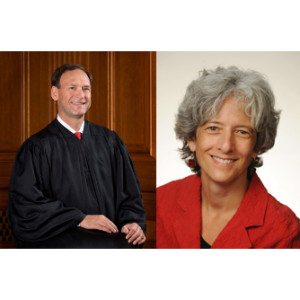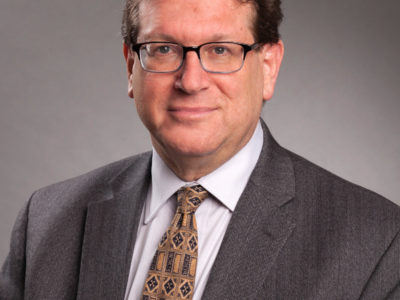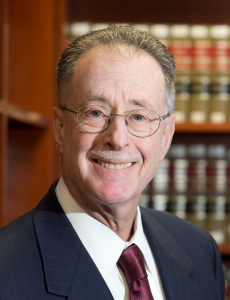Response by Professor Joan S. Meier1
Geo. Wash. L. Rev. Docket (Oct. Term 2014)
Ohio v. Clark, 575 U.S. ___ (2015).
Docket No. 13-1352; March 2, 2015; June 18, 2015
Slip Opinion | SCOTUSblog
In one fell swoop, and a unanimous one at that, the Supreme Court in Ohio v. Clark2 both helped ensure child abusers may be successfully prosecuted, and resolved several open questions about the scope of the Sixth Amendment confrontation right. Perhaps more controversially, the decision also adds momentum to the Court’s incremental retreat from the stringent standard Justice Scalia sought to ordain in Crawford v Washington3 and subsequent decisions.
Background on Clark
In Clark, a 3 year old’s preschool teachers noticed injuries and asked him where they came from. Eventually, the child said “Dee” did it. (Dee was the name of his mother’s pimp, who remained in charge of 3-year-old L.P. and 18-month old A.T., while he sent their mother several states away for prostitution.) The next day social workers tracked the children down at their grandmother’s, identified new and more severe injuries on both, and took them into custody.
At Clark’s trial for felonious assault, child endangerment and domestic violence, L.P. was deemed incompetent to testify but the teacher testified to his identification of Clark as the perpetrator of his injuries. Clark argued that use of the hearsay violated his 6th Amendment right to confront the witnesses against him, drawing on Crawford’s ruling that no “testimonial” out of court statement may be used at trial unless the witness was unavailable and the defendant had a chance to cross-examine them. Clark’s argument—that the statement was testimonial because the teacher was a mandated reporter and was gathering evidence for the State—while rejected at trial, was adopted on appeal by both the State Court of Appeals and the State Supreme Court. The U.S. Supreme Court reversed in a unanimous decision with two concurrences (one by Justice Scalia, joined by Justice Ginsburg, and one by Justice Thomas).
Advocates for victims of abuse heaved a sigh of relief with this decision: Had the Ohio Supreme Court’s ruling been upheld, prosecution of child abuse and protection of at-risk children would have become even harder than it is today, because children’s disclosures to independent third parties (many of whom are mandated reporters) are often considered more trustworthy than other disclosures (e.g., to their mothers who may be adversarial parties), and therefore critical to achieving convictions or protection.
Confrontation Jurisprudence
To understand the broader implications of Clark in jurisprudential context, one must go back to Crawford. The Crawford decision deliberately ushered in a sea change in confrontation jurisprudence,4 outlawing what had been standard operating procedure in thousands of criminal courtrooms every day. No longer was the confrontation right considered met by use of traditionally admissible “reliable” or “trustworthy” hearsay in prosecuting cases where the victim was unavailable to testify.5 The decision was greeted by many as a return to a principled approach truer to the original purpose of the Confrontation Clause. While the Crawford decision failed to define what statements are and are not “testimonial,”6 many defense advocates saw the impassioned opinion breathing new life into the confrontation right as signaling that a defendant’s confrontation right was virtually absolute, covering any out of court accusatory statements.
That Crawford was a radical shift—and a potentially destructive one for victims of family violence—was evident from the fact that, “within days—even hours—of the Crawford decision, prosecutors were dismissing or losing hundreds of domestic violence cases that would have presented little difficulty in the past.7 Although family violence was not at issue in Crawford, the primary impact of the case was—predictably—on domestic violence and child abuse cases, because these are the cases in which victims are often and predictably not able or willing to testify. While the domestic violence community had been absent from the Crawford case, they were alarmed by the Crawford decision. Leading organizations filed amicus briefs on behalf of the advocacy community and victims in the next two confrontation cases in the Court (Davis/Hammon and Giles), urging the Court not to define the new standard in a manner that made domestic violence and child abuse prosecutions virtually impossible.8
Whether or not because of the new amicus briefs, two subsequent decisions showed some hesitation about the breadth of the new confrontation right. In Davis v. Washington and Hammon v. Indiana,9 both involving police interrogation, the Court adopted a “primary purpose” test which allowed admission of statements seeking help in an “ongoing emergency” which were not made for the “primary purpose” of describing past events potentially for trial, based on an objective assessment of the “circumstances.”10 Thus the 911 call from the domestic violence victim during and right after her assault was admissible; the affidavit prepared with a police officer at the house after an incident of domestic violence was testimonial and not admissible. In Michigan v. Bryant11 a six-justice majority (Scalia and Ginsburg dissenting) emphasized that the intents of both a reasonable speaker and questioner in the circumstances are relevant to determining primary purpose.12 Bryant also emphasized the (in)formality of the conversation as an important factor in determining whether a statement’s primary purpose is testimonial.13 Thus, the statements of a shooting victim to police identifying the shooter were characterized as part of an ongoing emergency, informal, and nontestimonial.14 While both these decisions indicated a majority of the Court’s willingness to find accusatory statements to law enforcement not prohibited by the confrontation right, they did not clearly forecast to what extent the new jurisprudence would continue to cripple prosecutions of family violence and other cases where key witnesses were absent.
Children’s Statements
Indeed, the Crawford/Davis/Bryant line of cases left numerous questions unanswered, particularly with respect to children’s statements. For instance, to what extent does the testimonial analysis apply to statements made outside the context of law enforcement? How are the purposes of speakers and questioners weighed, when potentially different? How is the “primary purpose” test applied to children, many of whom lack any understanding of what a prosecution is? Should a child’s age dictate the analysis? And finally, the Clark question itself: To what extent does a mandatory reporting obligation transform a “civil” adult into a State proxy?
While scholars and advocates pondered these and other questions,15 state courts gradually began to carve out their own paths regarding children’s statements. Notably, the majority of courts side-stepped the question of children’s “purpose,” focusing more on the questioner’s intent and the particular (law enforcement or not) context. Many courts thus found young children’s statements, especially those to police, testimonial.16
Moving beyond law enforcement, while children’s statements made to purely medical personnel were widely ruled non-testimonial,17 children’s statements to social workers—who often play a dual role—divided state courts.18
Impact of Clark
This brief overview of lower court trends demonstrates that the Clark decision is more far-reaching than might be apparent at first glance. First, there is no question that Clark resolved the question presented—whether children’s statements at school to teachers who are mandatory reporters are per se testimonial: They are not.19 It thus laid to rest the defense argument that a mandatory reporting obligation per se converts non-law enforcement personnel into proxies for law enforcement.20
But the decision is far more significant than that. Both the majority opinion (joined by six justices) and Justice Scalia’s oppositional concurrence (joined by Justice Ginsburg) contain substantial text that actually suggests (1) that many state courts have been more protective of the confrontation right in cases involving children than a majority of the high Court believes is constitutionally required and (2) that new parameters are now available to limit the application of the confrontation right in non-police settings.
First, both the majority and Justice Scalia’s concurrence in Clark emphasize the impossibility of a 3-year-old’s having a testimonial intent.21 In stark contrast, to this author’s knowledge, not one state court has previously made a child’s intent or purpose (or lack thereof) the linchpin of a decision. The Clark Court’s language (and its unanimity) now indicates that prosecutors in future child abuse cases may be able to cite Clark to dismiss confrontation claims raised regarding young children’s statements.
Second, the majority goes out of its way to assert “statements to persons other than law enforcement officers . . . are much less likely to be testimonial than statements to law enforcement officers” [emphasis added]. Again, this is a more restrictive reading of the confrontation right than that of many lower courts which have rigorously applied the primary purpose test to doctors, nurses, social workers, and occasionally, teachers. At minimum, this dictum creates a strong presumption for prosecutors to invoke in future such cases (involving both children’s and adults’ statements).22
Third, both the majority and even Justice Scalia seem to be moving significantly closer to Justice Thomas’ oft-repeated plaint, that the historical view of the confrontation right should limit the right’s application solely to statements bearing “sufficient indicia of solemnity” to “qualify as testimonial.”23 Thus, the majority states that “[o]ne additional factor is ‘the informality of the situation and the interrogation,’” and Scalia’s concurrence emphasizes this factor even more.24
There can thus be no doubt that in numerous respects the tide of confrontation protections that came in with Crawford is moving at least part of the way back out. It is therefore not surprising that Justice Scalia so wrathfully accuses the majority of disrespect for his Crawford decision.25 However, as confrontation clause guru Professor Richard Friedman has pointed out, the justice’s fulminations may actually contribute to the outcome he fears, by over-stating the majority’s text and meaning.26
In the end, the Clark decision has unquestionably improved the State’s ability to prosecute and convict abusers of child and even adult victims, while, in dicta, putting a thumb on the scale on several previously open questions. Whether the decision is the beginning of the end of the Crawford revolution, as Justice Scalia seems to fear, remains to be seen.
1. Professor Meier co-authored an amicus brief in Clark on behalf of Domestic Violence Legal Empowerment Appeals Project (DV LEAP).
2. Ohio v. Clark, No. 13-1352, slip op. (U.S. June 18, 2015).
3. Crawford v. Washington, 541 U.S. 36 (2004).
4. Scalia’s concurrence complains most vociferously about the majority’s seeming indifference to his view of Crawford as having “rescued from the grave” the confrontation right. Id. at 2–3 (railing against the majority’s characterizing Crawford as merely “adopting a ‘different’ approach [from the Roberts approach]. . . as though Crawford is only a matter of twiddle-dum twiddle-dee preference”).
5. This standard had been adopted in Ohio v. Roberts, 448 U.S. 56 (1980).
6. The Court did rule that the police interrogation in that case as well as comparable formal law enforcement interrogations, depositions, etc, would necessarily be deemed testimonial.
7. Tom Lininger, Prosecuting Batterers After Crawford, 91 Va. L. Rev. 747, 749 (2005) (citations omitted). The Dallas Morning News reported that half of all domestic violence cases set for trial were being thrown out due to Crawford. Robert Tharp, Domestic Violence Cases Face New Test: Ruling That Suspects Can Confront Accusers Scares Some Victims From Court Dallas Morning News (July 6, 2004) at 1A. Professor Lininger’s post-Crawford survey of over sixty prosecutors’ offices in California, Oregon, and Washington found that 76% were more likely to drop such charges and that victims of domestic violence were now less safe in their communities. Lininger, supra at 749. See also Brief of Amici Curiae The National Network to End Domestic Violence et al, Davis v. Washington; Hammon v. Indiana, Nos. 05-5224 and 05-5705, pp. 16-19 and Appendix B (containing letters from prosecutors, victims and advocates describing the devastating impact Crawford was having on victims and prosecutions).
8. Brief of Amicus Curiae National Network to End Domestic Violence et al, Davis v. Washington; Hammon v. Indiana, Nos. 05-5224, 05-5705 (2006) available at http://www.dvleap.org/LinkClick.aspx?fileticket=YI2YxfLMufA%3d&tabid=179; Brief of Amicus Curiae DV LEAP et al, Giles v. California, No. 07-6053, (2008), available at http://www.dvleap.org/LinkClick.aspx?fileticket=GzQU04-Vpno%3d&tabid=179
9. Davis and Hammon are consolidated at 547 U.S. 813 (2006).
10. Davis/Hammond, 547 U.S. at 822.
11. Michigan v. Bryan, 562 U.S. 344 (2011),
12. Id. at 358, 367–68.
13. Id. at 366, 377.
14. Id. at 366.
15. See, e.g., Symposium, 82 Ind. L.J., 909–1079 (2007).
16. See, e.g., Wright v. State, 673 S.E.2d 249, 253 (Ga. 2009) (holding that a three-year-old’s statement to a policeman that “daddy did it” was testimonial because the emergency had ended); State v. Arnold, 933 N.E.2d 775 (Ohio 2010) (holding that child-victim’s statements to child advocacy center employee the day after being abused were testimonial when collected for the police, but nontestimonial when for purpose of making a medical diagnosis). But cf. State v. Arroyo, 284 Conn. 597, 630 n.20 (2007) (“[T]he mere fact that police are involved . . . because they are made privy to the information obtained in the interview, is not sufficient, without more, to render the interviews testimonial.”).
17; Medina v. State, 143 P.3d 471, 476 (Nev. 2006) (statements to Sexual Assault Nurse Examiner (SANE) were testimonial because primary purpose was to gather evidence).
18. See e.g., State v. Buda, 949 A.2d 761, 780 (N.J. 2008) (statements by a child to Division of Youth and Family Services were nontestimonial because the interviewer was “not collecting information about past events for prosecutorial purposes, but gathering data in order to assure a child’s future well-being.”); State v. Edinger, No. 05AP-31, 2006 WL827412 (Ohio Ct. App. March 30, 2006) (finding child’s statements nontestimonial because social worker’s purpose was for medical treatment, even though police watched interview). Compare Bobadilla v. Carlson, 575 F.3d 785, 791 (8th Cir. 2009) (child’s statements to the social worker were testimonial because interview was initiated by a police officer and conducted in the form of a police interrogation); State v. Justus, 205 S.W.3d 872, 880–81 (Mo. 2006) (statements to social worker were testimonial because the interview was conducted in such a way as to preserve testimony for trial); State v. Mack, 101 P.3d 349, 352 (Or. 2004) (child’s statements were testimonial because the Department of Human Services worker was acting as a proxy for police in gathering the information).
19. “[M]andatory reporting statutes alone cannot convert a conversation between a concerned teacher and her student into a law enforcement mission…” Clark, slip op. at 11 (majority opinion). Scalia’s concurrence tries to minimize this statement by “agree[ing” with the Court’s “refusal to decide . . . what effect Ohio’s mandatory-reporting law has in transforming a private party into a state actor . . . .” Id. at 1 (Scalia, J., concurring in the judgment). This characterization is hard to square with the majority’s language.
20. This core ruling is not terribly significant in that the argument had received little traction in lower courts, where mandatory reporting obligations had been treated as one factor, at most, in a broader primary purpose inquiry. See e.g., State v. Maguire, 78 A.3d 828, 835 (Conn. 2013)(remanding for new trial to decide whether primary purpose of therapist interview was testimonial, in light of mandatory reporting statute); in re T.T., 892 N.E.2d —, 1164-65 (Ill. App. 2008)(DCFS workers are not a “prosecutorial arm of the state” just because they are mandatory reporters, but their close working relationship with State’s Attorney makes statements they elicited testimonial).
21. Clark, slip op. at 9 (majority opinion) (“Statements by very young children will rarely, if ever, implicate the Confrontation Clause.”); Id. at 1 (Scalia, J., concurring in the judgment) (“L.P.’s primary purpose here was certainly not to invoke the coercive machinery of the State against Clark. His age refutes the notion that he is capable of forming such a purpose.”).
22. Again, Justice Scalia endeavors to minimize this language by asserting that he “agrees” with the Court’s “refusal to decide . . . whether a more permissive Confrontation Clause test . . . should apply to interrogations by private actors.” Id. at 1 (Scalia, J., concurring in the judgment). Again, this characterization is over-stated and of questionable accuracy.
23. Clark, slip op. at 2 (Thomas, J., concurring in the judgment).
24. Id. at 6 (majority opinion) (citing Davis/Hammon, 562 U.S. at 366, 377); See also id. at 2 (Scalia, J., concurring in the judgment) (“Nor did the conversation have the requisite solemnity necessary for testimonial statements. . . . [In Crawford] [w]e defined testimony as ‘a solemn declaration or affirmation made for the purpose of establishing or proving some fact . . . .’”).
25. Id. at 3 (Scalia, J., concurring in the judgment) (“[S]nide detractions do no harm; they are just indications of motive. Dicta on legal points, however, can do harm . . . .”).
26. Richard Friedman, Ohio v. Clark: Some Initial Thoughts, The Confrontation Blog, (June 19, 2015, 1:09 AM), http://confrontationright.blogspot.com/ (“I think that Justice Scalia sometimes has a tendency to read majority opinions with which he disagrees in what he considers the worst possible light — which can have unfortunate results for him if his comments tends to be self-fulfilling prophecies. I hope this is not such an instance.”); see, e.g., Clark, slip op. at 3 (Scalia, J., concurring in the judgment) (attacking the majority’s statement that the primary purpose test is “necessary, but not always sufficient” and fulminating that the majority is opening the door to some “other mysterious requirements.” An objective reading indicates the majority is simply acknowledging past decisions’ respect for Framing era admission of particular types of evidence, e.g., dying declarations).
Recommended Citation
Joan S. Meier, Response, Ohio v. Clark, Geo. Wash. L. Rev. Docket (June 22, 2015), http://www.gwlr.org/ohio-v-clark/.



